With an E Ink display instead of a keyboard, plus an extraordinarily thin chassis, the Lenovo Yoga Book C930 ($ 949.99) comes very close to being a futuristic tablet PC of the sort you might recognize from a TV show or movie like HBO’s Westworld. But despite looking 22nd-century and having novel features like the ability to translate your drawings from an E Ink screen to the main quad HD display, the Yoga Book is hobbled by its sluggish computing performance. That’s especially unfortunate since the Yoga C930 is a significantly upgraded and more expensive replacement for the original Yoga Book.
Similar Products
No Atoms Here
Gone is the Atom x5 processor of the original. Instead, the Yoga Book C930 offers an Intel Core i5 Y-series CPU. It’s one of Intel’s lowest-powered Core mobile chips, but it’s still far more powerful than the Atom is. That should mean a much snappier Windows experience, especially when it comes to switching between apps and navigating through feature-rich websites, but in practice the Yoga Book is still deficient in this area compared with its similarly priced competitors.

Also gone is the option to configure a Yoga Book with Android. The Yoga Book C930 is Windows-only, which is probably a good thing considering that the era of using Android as a tablet operating system seems to be waning. PCMag reviewed the Android version of the original Yoga Book, which cost $ 499, so the operating system and cost difference precludes a direct performance comparison between it and the C930.
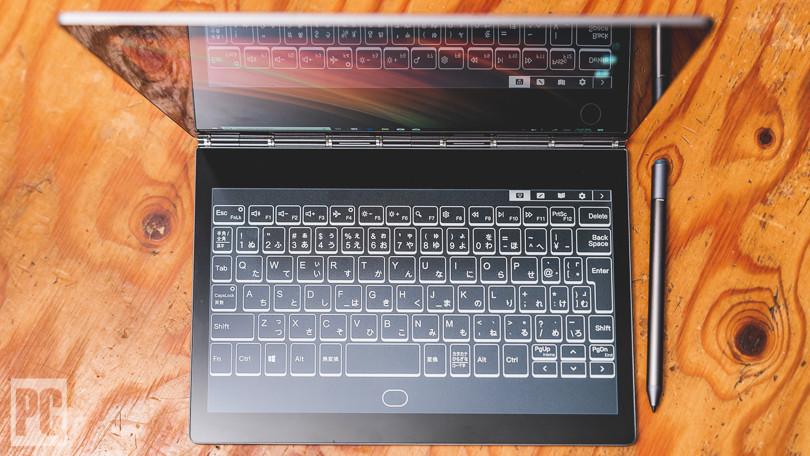
Still, the Yoga Book’s key strength has nothing to do with computing performance. Instead, you’ll buy this unique machine mainly for its diminutive form factor—it’s the only convertible hybrid laptop I’ve used that fits comfortably in one hand—as well as its E Ink display that functions as the keyboard, a note-taking and sketch pad, and much more.
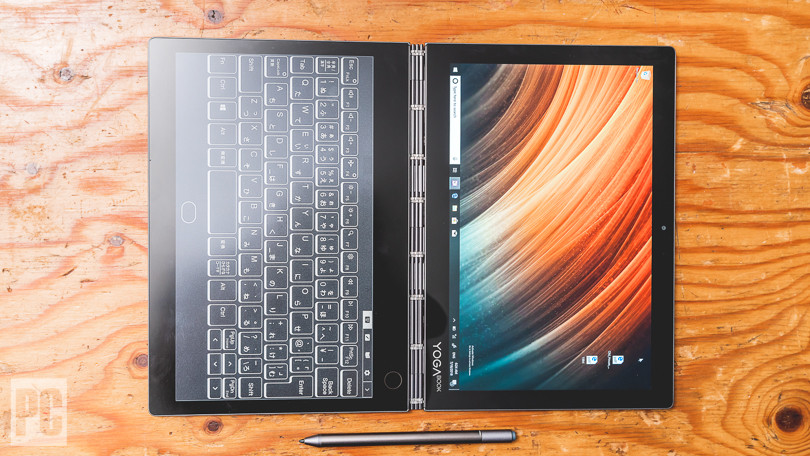
The entire package measures 0.39 by 10.25 by 7.1 inches (HWD) and weighs 1.71 pounds. That’s incredibly thin and light for a Windows laptop, though slightly heavier than the 1.52-pound original Yoga Book. The smallest convertibles PCMag has reviewed recently have 12-inch displays, such as the Lenovo Yoga 720 (0.6 by 11.5 by 8 inches, 2.53 pounds). The Yoga Book is so much smaller and lighter mostly because of its smaller 10.8-inch display, a size that’s more common in tablets like the Apple iPad than in traditional laptops.
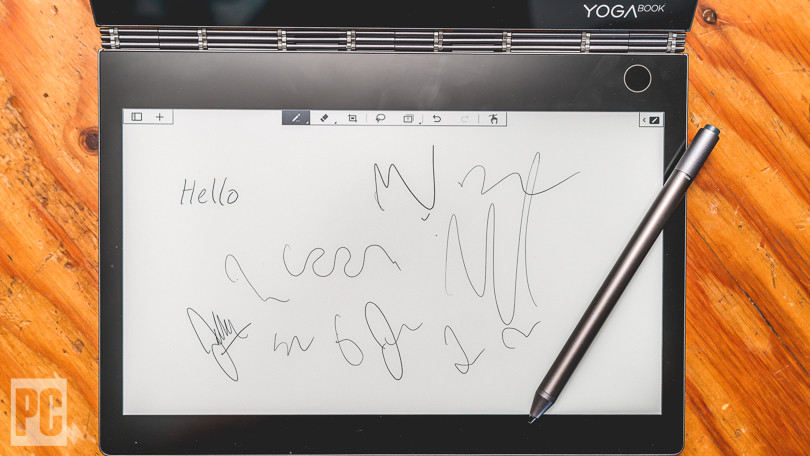
As brilliant and vivid as the quad HD (2,560-by-1,600-pixel) display is, it’s still not the most visually arresting part of the Yoga Book. That honor belongs to the second display that faces it on the laptop’s other half, where you’d expect to find the keyboard on a conventional laptop. It’s the same size as the main screen, but it uses E Ink instead of traditional LCDs or LEDs. The result is a monochrome display with a painfully slow refresh rate, but also one that consumes a minuscule amount of energy and is unaffected by bright ambient light.
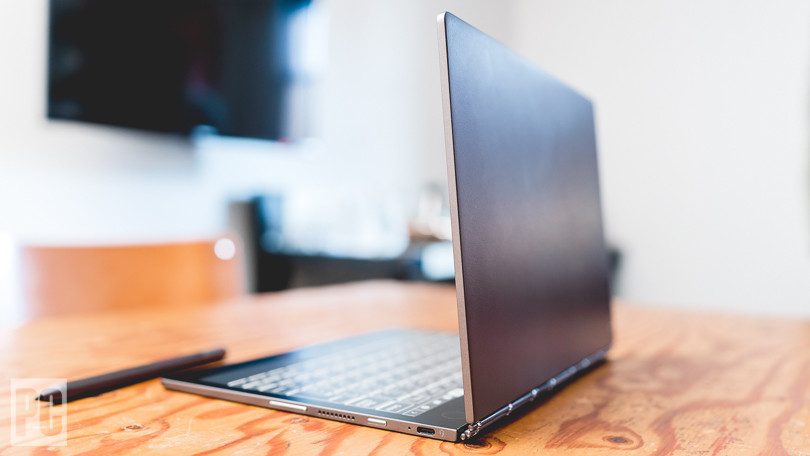

The Yoga Book C930’s E Ink display features three modes. By default it’s a keyboard, but you can tap a row of icons in the upper right corner to transform it into a digital slate similar to the Wacom Bamboo Folio, or an ereader similar to the Amazon Kindle.
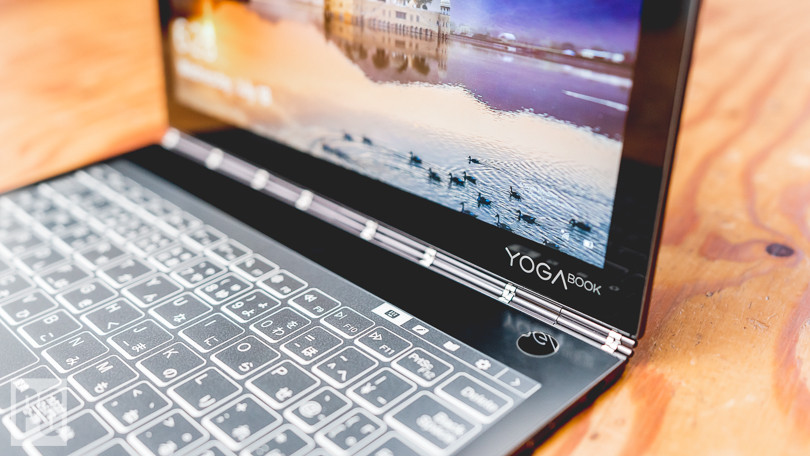
The E Ink display on the original Yoga Book was great as a pressure-sensitive drawing surface, but it suffered as an actual keyboard. Not so with the new version. Although the keys themselves are still flat and virtual, its response time seems to be greatly improved, with none of the issues around slow auto-correct and overly powerful haptic feedback that were evident on the original Yoga Book. I certainly wouldn’t write a novel on the Yoga Book C930, but other than the inability to find my way around the keyboard by feel, I had no problems typing a few sentences at a time without making mistakes.
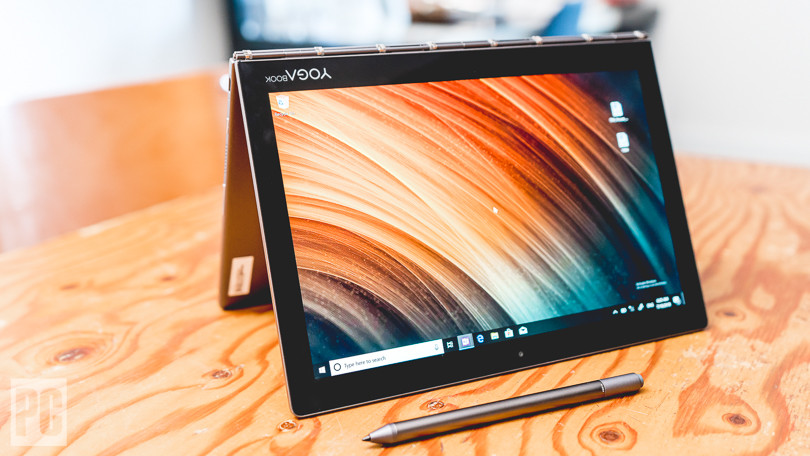
You can activate the vibrating feedback and turn response sounds on or off by tapping the settings menu in the upper right hand corner. There, you’ll also find options for customizing Lenovo’s unique touchpad solution. By default, the touchpad is hidden and appears only when you tap in the area below the spacebar, which gives the keyboard more room. You can also choose to shrink the keyboard to make room for a permanent touchpad, but I don’t recommend this since activating the touchpad whenever you need it is far easier than typing on cramped keys.
The included Wacom Active Pen offers 4,096 levels of pressure sensitivity, connects via Bluetooth, and uses disposable AAA batteries. It attaches to the back of the display lid with a powerful handy magnet when you’re not using it, and it’s far more accurate and precise than a cheap capacitive stylus. You can use it for drawing or navigating through Windows 10 on the primary display, or use it on the E Ink display in Note mode. The selling point here is that you can flip the hinge 360 degrees, turn off the main display, and take notes or make drawings while consuming very little power.
When you’re done, you can then draw a circle around your words or images and copy them to the clipboard, from which you can then paste them into the Windows app of your choice, including an optical character recognition (OCR) app. It’s a nifty and novel experience, but in my testing, drawing and writing on the E Ink display was no easier than using the stylus on the main display, due primarily to the sluggish refresh rate.
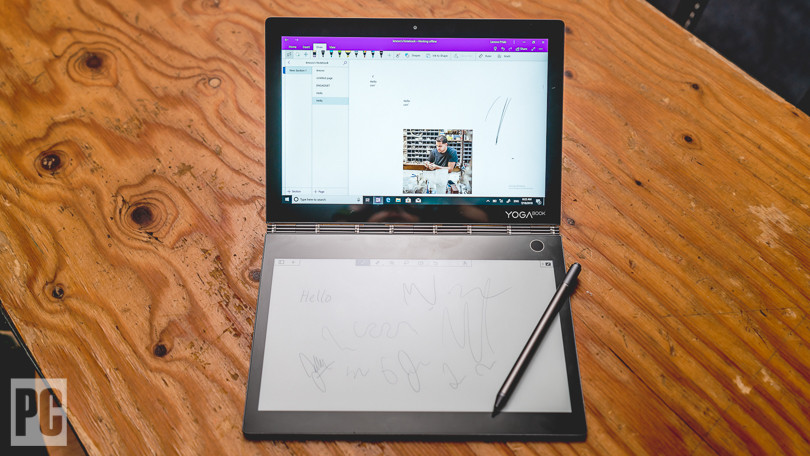
Equally novel is the possibility of using the E Ink display as an ereader. In fact, the Yoga Book C930 has the potential to replace your laptop, your tablet, and your Kindle. In practice, though, there’s currently no support for any ebook file formats, which limits you to displaying PDFs and image files. At least the process for transferring these files to the E Ink display is straightforward—you can navigate the Windows file structure directly on the display.
Lenovo plans to add support for ePub and Mobi ebook formats next year. Until that happens, the reader portion of the Yoga Book C930 is mostly a gimmick.
The most gimmicky feature of all, though, is the solution Lenovo came up with for opening the display lid. Since there’s no lip of any kind, the two halves of the Yoga Book C930 line up perfectly, making it nearly impossible to prise them open with your fingertips. So, thanks to an ingenious use of magnets and motion detection, you can knock twice on the outside of the lid to pop it open.
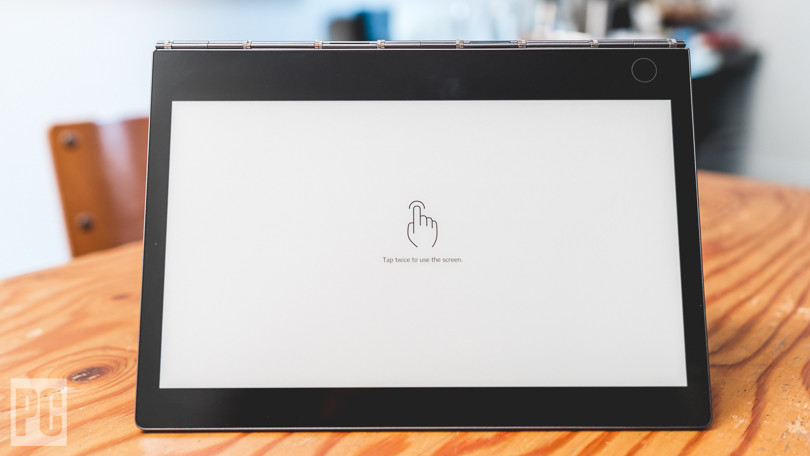
It’s quite futuristic—when it works, which unfortunately only happened about half of the time during several days of testing. More concerning, the Yoga Book C930 would occasionally pop open of its own accord when I set it down firmly on a table. If you can’t get it to open by knocking, you can also press twice on the side-mounted power button to pop open the lid.
The two halves of the Yoga Book C930 connect using Lenovo’s iconic watchband-style hinge. Interestingly, this style of hinge is disappearing from Lenovo’s flagship convertible laptop, the new Yoga C930, in favor of another unique hinge design, this one with a built-in speaker.
Speaking of the Yoga C930, it will be very easy for the nomenclature to confuse shoppers. The Yoga C930 is a larger 14-inch convertible laptop, with a more powerful U-series Intel Core i5 or Core i7 processor and a conventional keyboard. Add a “Book” to the name, and you get the very different model I’m reviewing here, with the 10-inch screen and the E Ink lower half.
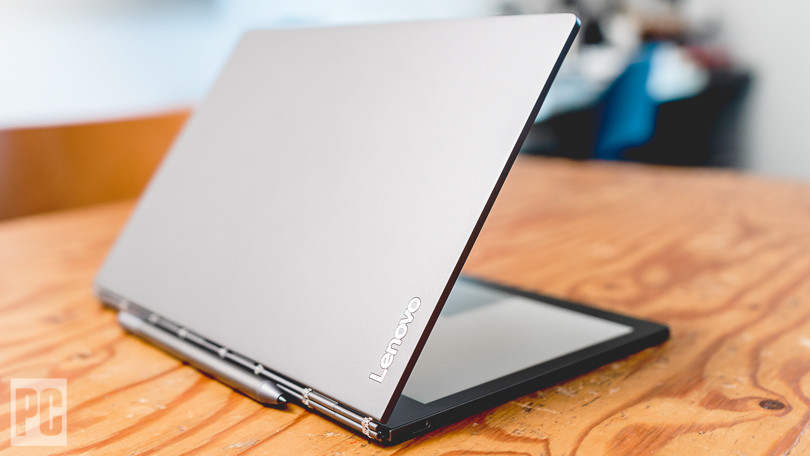
For Nearly a Grand, Needs More Pep
Our review unit has 4GB of memory and a 128GB SSD, which precludes using it for marathon browsing sessions with lots of tabs open or as a repository for your 4K movie collection. The port selection amounts to two USB Type-C ports, either of which can charge the Yoga Book C930. They replace the micro USB and micro HDMI ports on the original Yoga Book, which means connecting to external displays will require a dongle.
On the plus side, there’s a slot on the left edge that accepts both micro SD cards to boost storage and a SIM card to provide cellular connectivity. As mentioned earlier, Lenovo says it plans to sell a 4G LTE version, something that it rarely offers with its other consumer laptops, although the review unit on hand here is not so equipped. Bluetooth 4.2 and 802.11ac Wi-Fi round out the wireless options.
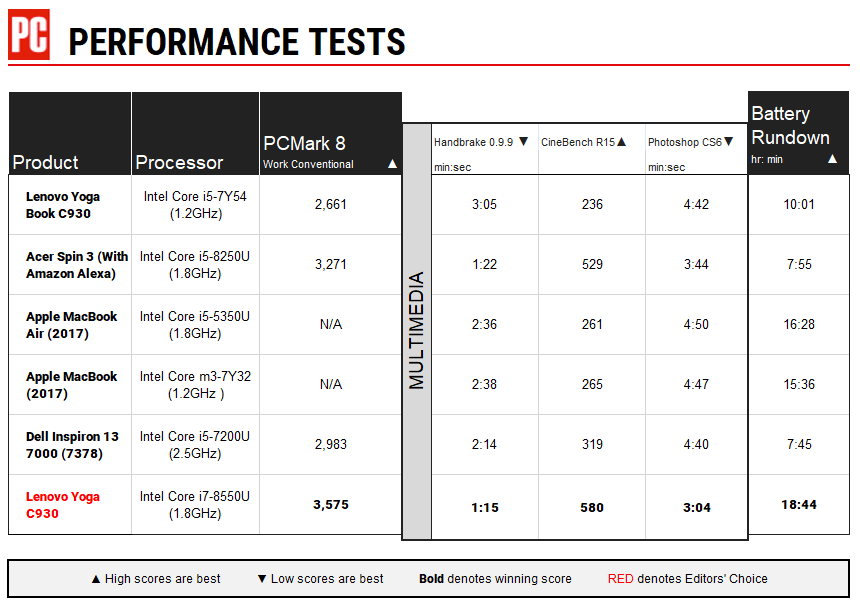
Inside, the Intel Core i5-7Y54 results in the Yoga Book C930 receiving disappointing performance scores compared with other laptops in its price range. The “Y” in the processor name indicates that this CPU is efficient enough to require no cooling fan. That means the Yoga Book C930 is almost silent under any workload, though it does get quite warm to the touch.
It also means that this laptop is a significantly worse performer on specialized tasks such as multimedia editing. It was the slowest among a group of five competing convertible laptops on our Handbrake video-encoding test (3 minutes and 5 seconds) and Cinebench 3D rendering test (a score of 236).
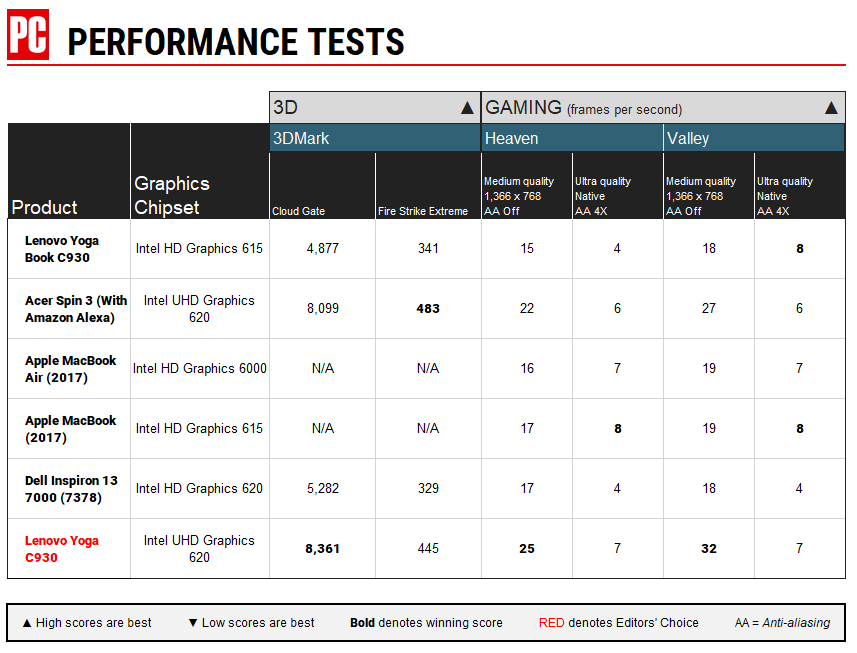
Although it’s clear from the Yoga Book C930’s physical appearance that it’s designed for note-taking and doodling rather than 3D rendering, it’s tough to stomach that you could spend roughly the same amount of money on a larger, more capable machine like the non-“Book” Yoga C930. Even the cheaper Dell Inspiron 13 7000 and Acer Spin 3 performed far better on the multimedia tests.
The story is much the same when it comes to the general-purpose PCMark 8 benchmark, which simulates common computing tasks such as word processing and web browsing. The Yoga Book C930’s score of 2,661 on this test is far below the 3,000 minimum that represents lag-free everyday performance.
Indeed, I did experience occasional sluggishness during most of my real-world testing with the Yoga Book C930. Everything from resizing app windows to navigating quickly back and forth between web pages and tabs in Microsoft Edge resulted in noticeable lag.
Neither is the Yoga Book C930 adept at playing demanding games, although at least this is one deficiency that it shares with the rest of its competitors, almost all of which offer frame rates far below the minimum 30 frames per second we consider acceptable for smooth gameplay on the Heaven and Valley gaming simulations.
The one bright spot when it comes to performance is battery life. Lasting 10 hours on our battery-rundown test means that you should be able to get through a full day of plugged-in use. The laptop actually lasted a full weekend away from a power outlet in my testing, although I used it only for brief web searches during that time.
A Specialized Laptop, a Bit Too Dear
Unfortunately, two major downsides shadow Lenovo’s improvements to the Yoga Book. Many prospective owners who plan to use this laptop for light-duty tasks like taking notes will be able to live with the lackluster computing performance. But the price increase is harder to stomach.
The original Windows Yoga Book, which is no longer available for purchase, started at $ 549. The Yoga Book C930 is $ 949.99, a whopping 73 percent uptick. That means the Yoga Book C930 is now competing with premium ultraportable laptops, in addition to tablets like the far less expensive Apple iPad.
The E Ink display and other novel features simply don’t justify this additional expense. Ultimately, the Yoga Book C930 is a great conversation piece if you can afford it, but sensible shoppers would do better to buy a larger convertible laptop for roughly the same money. (Just drop the “Book” from the name, and you have a great alternative right there.)








